The custom crockery of today’s most renowned chefs often comes from the most unexpected places. Take McQueen Pottery, a ceramics studio in downtown Maryville, Tennessee, run by potter Leanne McQueen. Each morning, McQueen cuts through her private garden to the workshop, studio, and retail space next door, where she joins the “henhouse” of potter s and potters assistants that make up their beloved label.
“We grow and learn from them,” she says of the chefs she works with. “The concepts they bring to us stretch our own ideas of what the traditional plate can mean.”
Perhaps that creative receptiveness is why McQueen’s carefully thrown plates, glasses, bowls, and platters have graced the tables of Sean Brock’s Husk and Joseph Lenn’s Barn at Blackberry Farm, to name a few. For McQueen, the harvest season is an ideal opportunity to showcase the beauty of her organic, often minimalist pieces, as canvases that both compliment and ground chef’s play with the abundance of autumn.
Here, she sets a table that echoes the potlucks and intimate gatherings of her and her fellow studio mates during the turning of the season, when the temperature drops in the cool altitudes of the Great Smoky Mountains of Tennessee. McQueen’s signature simple grace strikes that elusive balance between inviting and refined that so many of today’s chefs are striving–and succeeding–in capturing…thanks in part, of course, to the requisite aid of McQueen’s subtly composed wares.


Leanne McQueen’s Tips for Your Harvest Table
- Use bud vases filled with fresh cuts from the yard. Groupings of three allow color for the table but do not require a large amount of flowers at the end of the season when botanical gardens are growing bare.
- I love using large oblong shapes for charcuterie plates. This breaks up the table and creates a visual composition without taking up too much space.


- Mixing and matching traditional and handmade elements, like this low-slung woven basket, add interest and depth to the table.
- Vary the height of the pieces you use. Doing so helps create visual interest and prevents the table from looking flat. Opposite:
- I like to use white or neutral dishes on my table. I look at the plate as a canvas for the food that it should highlight, not compete with.
share
trending content
-
FINAL Vote for Your Favorite 2025 Southern Culinary Town
-
Get To Know Roanoke, Virginia
-
Shrimp and Grits: A History
by Erin Byers Murray -
New Myrtle Beach Restaurants Making Waves
-
FINAL VOTING for Your Favorite Southern Culinary Town
More From At the Table
-
12 Recipes for a Vegetarian Thanksgiving
-
A Simpler Thanksgiving
-
Halloween Recipe Round-Up
-
The Swordfish Sea Change
-
The Harvest: Apple Recipe Round-Up









